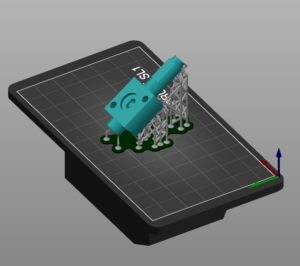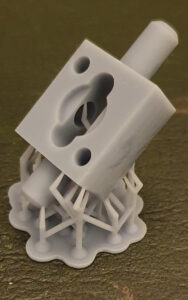RepRap is the technology on which Josef Průša built his company, Prusa Research. A while ago, in recognition of this, he very kindly gave Adrian a Prusa SL1 – one of his open-source stereolithography machines – and we have been using it recently in a number of projects. Here is our setup:
The actual machine is the one with the orange hood. On the left is the cleaning and curing station (CW1) that goes with it.
It is very easy to use, though a bit messier than FFF 3D printing, if that’s what you are used to. You load your items to be printed into the slicer and either select automatic support or (better) plan it out yourself:
If you are used to FFF 3D printing, this is the unusual step, as the support requirements are completely different.
First, you position the part at an angle around 45o for best results. Then you click points on the underside of the object. These will be the leaves of a support tree. At them, the supports will touch your model in a fine-tipped cone. In our experience you need to put plenty of points (every two or three millimetres) on down-facing edges, and on down-facing surfaces, particularly near the bottom of the part to be printed. (The machine prints upside-down, so those parts will be the first to be printed and need support to get them established.) When you’ve finished adding points, the software constructs the tree automatically.
Then you send the file over your network to the machine and press print. The machine tells you how much resin to pour up to the marks in its tank and, when you’ve done that, you hit GO.
If you’ve got everything right your part will be presented at the top of the machine when it’s finished, together with a certain amount of residual sticky resin, which needs to be washed off.
You put rubber gloves on and now do the trickiest part of the process, which is to take the build-plate out of the machine and clamp it into the top plate of the wash bath without dripping resin everywhere. Have kitchen wipes handy…
The plate drops into a bath of iso-propyl alcohol (IPA) in the cleaning and curing station. This has a magnetic stirrer in the bottom which spins and washes the uncured resin off your part and some, though not all, of the build plate. The same machine then drys it and hits it with more UV light to complete the cure.
We find that this machine produces parts with much higher quality than FFF printing. It’s a bit slower for small parts, faster for big ones (because it flashes a whole layer at once). It also makes water- and gas-tight parts that are completely solid.
We have a policy of not endorsing other people’s products, but we can say that we are very pleased with this one, and not just because it was given to us free. It fills a very useful engineering gap in what we can print. We are very grateful to Josef for giving it to us.
Connect with us
Keep up to date on the latest RepRap Ltd news:




